Run the Mattermost Access Request plugin
This guide explains how to integrate Teleport access requests with Mattermost, an open source messaging platform. The Teleport Mattermost plugin notifies individuals of access requests. Users can then approve and deny access requests by following the message link, making it easier to implement security best practices without compromising productivity.
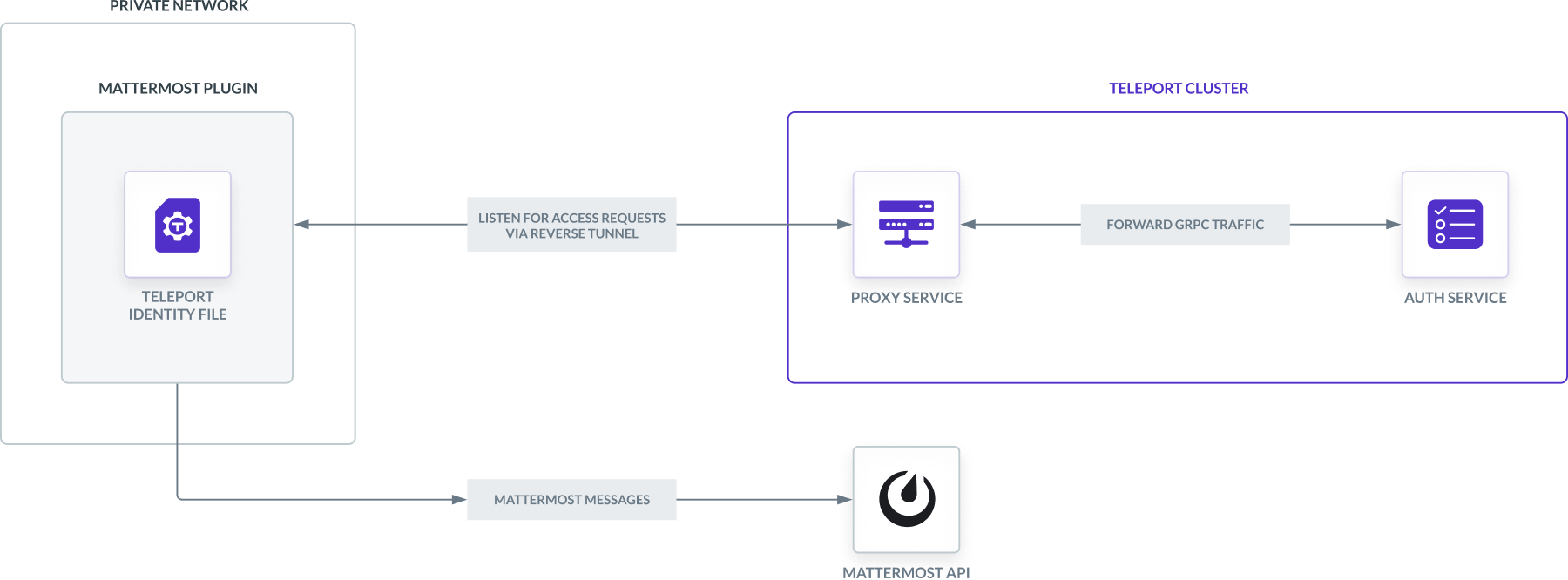
This integration is hosted on Teleport Cloud
In Teleport Enterprise Cloud, Teleport manages the Mattermost integration for you, and you can enroll the Mattermost integration from the Teleport Web UI.
Visit the Teleport Web UI and click Access Management on the menu bar at the top of the screen.
On the left sidebar, click Enroll New Integration to visit the "Enroll New Integration" page:
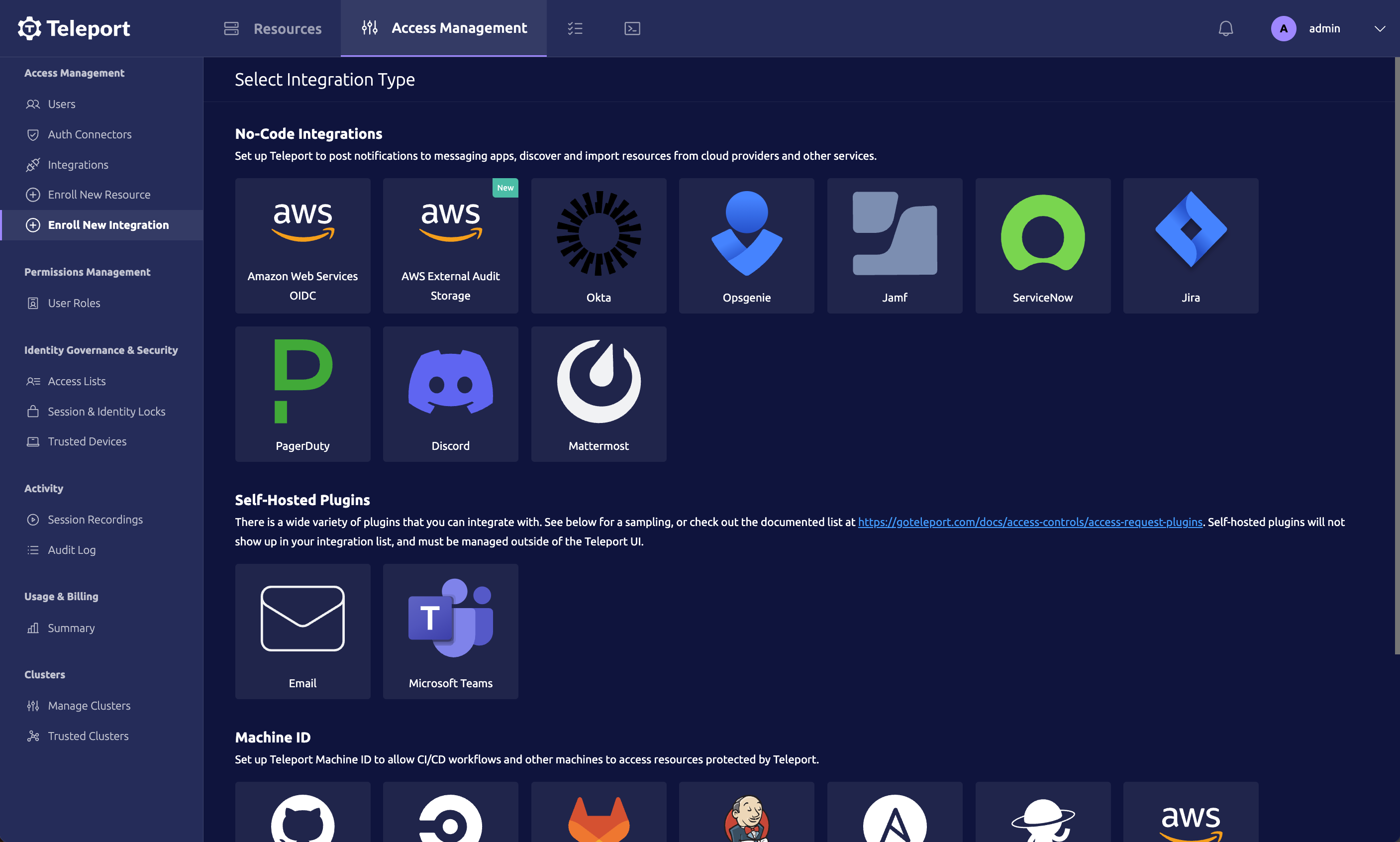
On the "Select Integration Type" menu, click the tile for your integration. You will see a page with instructions to set up the integration, as well as a form that you can use to configure the integration.
Prerequisites
-
A running Teleport cluster. If you want to get started with Teleport, sign up for a free trial.
-
The Enterprise
tctladmin tool andtshclient tool version >= 15.4.22, which you can download from your Teleport account workspace or the Teleport Installation Downloads page.
Recommended: Configure Machine ID to provide short-lived Teleport
credentials to the plugin. Before following this guide, follow a Machine ID
deployment guide
to run the tbot binary on your infrastructure.
- A Mattermost account with admin privileges. This plugin has been tested with Mattermost v7.0.1.
- Either a Linux host or Kubernetes cluster where you will run the Teleport Mattermost plugin.
- To check that you can connect to your Teleport cluster, sign in with
tsh login, then verify that you can runtctlcommands using your current credentials.tctlis supported on macOS and Linux machines. For example:If you can connect to the cluster and run the$ tsh login --proxy=teleport.example.com --user=email@example.com
$ tctl status
# Cluster teleport.example.com
# Version 15.4.22
# CA pin sha256:abdc1245efgh5678abdc1245efgh5678abdc1245efgh5678abdc1245efgh5678tctl statuscommand, you can use your current credentials to run subsequenttctlcommands from your workstation. If you host your own Teleport cluster, you can also runtctlcommands on the computer that hosts the Teleport Auth Service for full permissions.
Step 1/8. Define RBAC resources
Before you set up the Teleport Mattermost plugin, you need to enable Role Access Requests in the Teleport Proxy Service or Teleport Auth Service.
For the purpose of this guide, we will define an editor-requester role, which
can request the built-in editor role, and an editor-reviewer role that can
review requests for the editor role.
Create a file called editor-request-rbac.yaml with the following content:
kind: role
version: v5
metadata:
name: editor-reviewer
spec:
allow:
review_requests:
roles: ['editor']
---
kind: role
version: v5
metadata:
name: editor-requester
spec:
allow:
request:
roles: ['editor']
thresholds:
- approve: 1
deny: 1
Create the roles you defined:
$ tctl create -f editor-request-rbac.yaml
role 'editor-reviewer' has been created
role 'editor-requester' has been created
Allow yourself to review requests by users with the editor-requester role by
assigning yourself the editor-reviewer role.
Assign the editor-reviewer role to your Teleport user by running the appropriate
commands for your authentication provider:
- Local User
- GitHub
- SAML
- OIDC
-
Retrieve your local user's roles as a comma-separated list:
$ ROLES=$(tsh status -f json | jq -r '.active.roles | join(",")') -
Edit your local user to add the new role:
$ tctl users update $(tsh status -f json | jq -r '.active.username') \
--set-roles "${ROLES?},editor-reviewer" -
Sign out of the Teleport cluster and sign in again to assume the new role.
-
Retrieve your
githubauthentication connector:$ tctl get github/github --with-secrets > github.yamlNote that the
--with-secretsflag adds the value ofspec.signing_key_pair.private_keyto thegithub.yamlfile. Because this key contains a sensitive value, you should remove the github.yaml file immediately after updating the resource. -
Edit
github.yaml, addingeditor-reviewerto theteams_to_rolessection.The team you should map to this role depends on how you have designed your organization's role-based access controls (RBAC). However, the team must include your user account and should be the smallest team possible within your organization.
Here is an example:
teams_to_roles:
- organization: octocats
team: admins
roles:
- access
+ - editor-reviewer -
Apply your changes:
$ tctl create -f github.yaml -
Sign out of the Teleport cluster and sign in again to assume the new role.
-
Retrieve your
samlconfiguration resource:$ tctl get --with-secrets saml/mysaml > saml.yamlNote that the
--with-secretsflag adds the value ofspec.signing_key_pair.private_keyto thesaml.yamlfile. Because this key contains a sensitive value, you should remove the saml.yaml file immediately after updating the resource. -
Edit
saml.yaml, addingeditor-reviewerto theattributes_to_rolessection.The attribute you should map to this role depends on how you have designed your organization's role-based access controls (RBAC). However, the group must include your user account and should be the smallest group possible within your organization.
Here is an example:
attributes_to_roles:
- name: "groups"
value: "my-group"
roles:
- access
+ - editor-reviewer -
Apply your changes:
$ tctl create -f saml.yaml -
Sign out of the Teleport cluster and sign in again to assume the new role.
-
Retrieve your
oidcconfiguration resource:$ tctl get oidc/myoidc --with-secrets > oidc.yamlNote that the
--with-secretsflag adds the value ofspec.signing_key_pair.private_keyto theoidc.yamlfile. Because this key contains a sensitive value, you should remove the oidc.yaml file immediately after updating the resource. -
Edit
oidc.yaml, addingeditor-reviewerto theclaims_to_rolessection.The claim you should map to this role depends on how you have designed your organization's role-based access controls (RBAC). However, the group must include your user account and should be the smallest group possible within your organization.
Here is an example:
claims_to_roles:
- name: "groups"
value: "my-group"
roles:
- access
+ - editor-reviewer -
Apply your changes:
$ tctl create -f oidc.yaml -
Sign out of the Teleport cluster and sign in again to assume the new role.
Create a user called myuser who has the editor-requester role. This user
cannot edit your cluster configuration unless they request the editor role:
$ tctl users add myuser --roles=editor-requester
tctl will print an invitation URL to your terminal. Visit the URL and log in
as myuser for the first time, registering credentials as configured for your
Teleport cluster.
Later in this guide, you will have myuser request the editor role so you can
review the request using the Teleport plugin.
Step 2/8. Install the Teleport Mattermost plugin
- Self-Hosted
- Teleport Enterprise Cloud
We recommend installing Teleport plugins on the same host as the Teleport Proxy Service. This is an ideal location as plugins have a low memory footprint, and require both public internet access and Teleport Auth Service access.
Install the Teleport Mattermost plugin on a host that can access both your Teleport Proxy Service and your Mattermost deployment.
- Download
- Docker Image
- From Source
- Helm Chart
We currently only provide linux-amd64 binaries. You can also compile these
plugins from source. You can run the plugin from a remote host or your local
development machine.
$ curl -L -O https://get.gravitational.com/teleport-access-mattermost-v15.4.22-linux-amd64-bin.tar.gz
$ tar -xzf teleport-access-mattermost-v15.4.22-linux-amd64-bin.tar.gz
$ cd teleport-access-mattermost
$ sudo ./install
Make sure the binary is installed:
$ teleport-mattermost version
teleport-mattermost v15.4.22 git:teleport-mattermost-v15.4.22-fffffffff go1.21
We currently only provide Docker images for linux-amd64.
Pull the Docker image for the latest access request plugin by running the following command:
$ docker pull public.ecr.aws/gravitational/teleport-plugin-mattermost:15.4.22
Make sure the plugin is installed by running the following command:
$ docker run public.ecr.aws/gravitational/teleport-plugin-mattermost:15.4.22 version
teleport-mattermost v15.4.22 git:teleport-mattermost-v15.4.22-api/14.0.0-gd1e081e 1.21
For a list of available tags, visit Amazon ECR Public Gallery.
To install from source you need git and go installed. If you do not have Go
installed, visit the Go downloads page.
$ git clone https://github.com/gravitational/teleport -b branch/v15
$ cd teleport/integrations/access/mattermost
$ git checkout 15.4.22
$ make
Move the teleport-mattermost binary into your PATH.
Make sure the binary is installed:
$ teleport-mattermost version
teleport-mattermost v15.4.22 git:teleport-mattermost-v15.4.22-fffffffff go1.21
Allow Helm to install charts that are hosted in the Teleport Helm repository:
$ helm repo add teleport https://charts.releases.teleport.dev
Update the cache of charts from the remote repository:
$ helm repo update
Step 3/8. Create a user and role for the plugin
Teleport's Access Request plugins authenticate to your Teleport cluster as a user with permissions to list and read Access Requests. This way, plugins can retrieve Access Requests from the Teleport Auth Service and present them to reviewers.
Define a user and role called access-plugin by adding the following content to
a file called access-plugin.yaml:
kind: role
version: v5
metadata:
name: access-plugin
spec:
allow:
rules:
- resources: ['access_request']
verbs: ['list', 'read']
- resources: ['access_plugin_data']
verbs: ['update']
---
kind: user
metadata:
name: access-plugin
spec:
roles: ['access-plugin']
version: v2
Create the user and role:
$ tctl create -f access-plugin.yaml
As with all Teleport users, the Teleport Auth Service authenticates the
access-plugin user by issuing short-lived TLS credentials. In this case, we
will need to request the credentials manually by impersonating the
access-plugin role and user.
If you are running a self-hosted Teleport Enterprise deployment and are using
tctl from the Auth Service host, you will already have impersonation
privileges.
To grant your user impersonation privileges for access-plugin, define a role
called access-plugin-impersonator by pasting the following YAML document into
a file called access-plugin-impersonator.yaml:
kind: role
version: v5
metadata:
name: access-plugin-impersonator
spec:
allow:
impersonate:
roles:
- access-plugin
users:
- access-plugin
Create the access-plugin-impersonator role:
$ tctl create -f access-plugin-impersonator.yaml
If you are providing identity files to the plugin with Machine ID, assign the
access-plugin role to the Machine ID bot user. Otherwise, assign this role to
the user you plan to use to generate credentials for the access-plugin role
and user:
Assign the access-plugin-impersonator role to your Teleport user by running the appropriate
commands for your authentication provider:
- Local User
- GitHub
- SAML
- OIDC
-
Retrieve your local user's roles as a comma-separated list:
$ ROLES=$(tsh status -f json | jq -r '.active.roles | join(",")') -
Edit your local user to add the new role:
$ tctl users update $(tsh status -f json | jq -r '.active.username') \
--set-roles "${ROLES?},access-plugin-impersonator" -
Sign out of the Teleport cluster and sign in again to assume the new role.
-
Retrieve your
githubauthentication connector:$ tctl get github/github --with-secrets > github.yamlNote that the
--with-secretsflag adds the value ofspec.signing_key_pair.private_keyto thegithub.yamlfile. Because this key contains a sensitive value, you should remove the github.yaml file immediately after updating the resource. -
Edit
github.yaml, addingaccess-plugin-impersonatorto theteams_to_rolessection.The team you should map to this role depends on how you have designed your organization's role-based access controls (RBAC). However, the team must include your user account and should be the smallest team possible within your organization.
Here is an example:
teams_to_roles:
- organization: octocats
team: admins
roles:
- access
+ - access-plugin-impersonator -
Apply your changes:
$ tctl create -f github.yaml -
Sign out of the Teleport cluster and sign in again to assume the new role.
-
Retrieve your
samlconfiguration resource:$ tctl get --with-secrets saml/mysaml > saml.yamlNote that the
--with-secretsflag adds the value ofspec.signing_key_pair.private_keyto thesaml.yamlfile. Because this key contains a sensitive value, you should remove the saml.yaml file immediately after updating the resource. -
Edit
saml.yaml, addingaccess-plugin-impersonatorto theattributes_to_rolessection.The attribute you should map to this role depends on how you have designed your organization's role-based access controls (RBAC). However, the group must include your user account and should be the smallest group possible within your organization.
Here is an example:
attributes_to_roles:
- name: "groups"
value: "my-group"
roles:
- access
+ - access-plugin-impersonator -
Apply your changes:
$ tctl create -f saml.yaml -
Sign out of the Teleport cluster and sign in again to assume the new role.
-
Retrieve your
oidcconfiguration resource:$ tctl get oidc/myoidc --with-secrets > oidc.yamlNote that the
--with-secretsflag adds the value ofspec.signing_key_pair.private_keyto theoidc.yamlfile. Because this key contains a sensitive value, you should remove the oidc.yaml file immediately after updating the resource. -
Edit
oidc.yaml, addingaccess-plugin-impersonatorto theclaims_to_rolessection.The claim you should map to this role depends on how you have designed your organization's role-based access controls (RBAC). However, the group must include your user account and should be the smallest group possible within your organization.
Here is an example:
claims_to_roles:
- name: "groups"
value: "my-group"
roles:
- access
+ - access-plugin-impersonator -
Apply your changes:
$ tctl create -f oidc.yaml -
Sign out of the Teleport cluster and sign in again to assume the new role.
You will now be able to generate signed certificates for the access-plugin
role and user.
Step 4/8. Export the access plugin identity
Give the plugin access to a Teleport identity file. We recommend using Machine
ID for this in order to produce short-lived identity files that are less
dangerous if exfiltrated, though in demo deployments, you can generate
longer-lived identity files with tctl:
- Machine ID
- Long-lived identity files
Configure tbot with an output that will produce the credentials needed by
the plugin. As the plugin will be accessing the Teleport API, the correct
output type to use is identity.
For this guide, the directory destination will be used. This will write these
credentials to a specified directory on disk. Ensure that this directory can
be written to by the Linux user that tbot runs as, and that it can be read by
the Linux user that the plugin will run as.
Modify your tbot configuration to add an identity output.
If running tbot on a Linux server, use the directory output to write
identity files to the /opt/machine-id directory:
outputs:
- type: identity
destination:
type: directory
# For this guide, /opt/machine-id is used as the destination directory.
# You may wish to customize this. Multiple outputs cannot share the same
# destination.
path: /opt/machine-id
If running tbot on Kubernetes, write the identity file to Kubernetes secret
instead:
outputs:
- type: identity
destination:
type: kubernetes_secret
name: teleport-plugin-mattermost-identity
If operating tbot as a background service, restart it. If running tbot in
one-shot mode, execute it now.
You should now see an identity file under /opt/machine-id or a Kubernetes
secret named teleport-plugin-mattermost-identity. This contains the private key and signed
certificates needed by the plugin to authenticate with the Teleport Auth
Service.
Like all Teleport users, access-plugin needs signed credentials in order to
connect to your Teleport cluster. You will use the tctl auth sign command to
request these credentials.
The following tctl auth sign command impersonates the access-plugin user,
generates signed credentials, and writes an identity file to the local
directory:
$ tctl auth sign --user=access-plugin --out=identity
The plugin connects to the Teleport Auth Service's gRPC endpoint over TLS.
The identity file, identity, includes both TLS and SSH credentials. The
plugin uses the SSH credentials to connect to the Proxy Service, which
establishes a reverse tunnel connection to the Auth Service. The plugin
uses this reverse tunnel, along with your TLS credentials, to connect to the
Auth Service's gRPC endpoint.
Certificate Lifetime
By default, tctl auth sign produces certificates with a relatively short
lifetime. For production deployments, we suggest using Machine
ID to programmatically issue and renew
certificates for your plugin. See our Machine ID getting started
guide to learn more.
Note that you cannot issue certificates that are valid longer than your existing credentials.
For example, to issue certificates with a 1000-hour TTL, you must be logged in with a session that is
valid for at least 1000 hours. This means your user must have a role allowing
a max_session_ttl of at least 1000 hours (60000 minutes), and you must specify a --ttl
when logging in:
$ tsh login --proxy=teleport.example.com --ttl=60060
If you are running the plugin on a Linux server, create a data directory to hold certificate files for the plugin:
$ sudo mkdir -p /var/lib/teleport/api-credentials
$ sudo mv identity /var/lib/teleport/plugins/api-credentials
If you are running the plugin on Kubernetes, Create a Kubernetes secret that contains the Teleport identity file:
$ kubectl -n teleport create secret generic --from-file=identity teleport-plugin-mattermost-identity
Once the Teleport credentials expire, you will need to renew them by running the
tctl auth sign command again.
Step 5/8. Register a Mattermost bot
Now that you have generated the credentials your plugin needs to connect to your Teleport cluster, register your plugin with Mattermost so it can send Access Request messages to your workspace.
In Mattermost, click the menu button in the upper left of the UI, then click System Console → Integrations → Bot Accounts.
Set "Enable Bot Account Creation" to "true".

This will allow you to create a new bot account for the Mattermost plugin.
Go back to your team. In the menu on the upper left of the UI, click Integrations → Bot Accounts → Add Bot Account.
Set the "Username", "Display Name", and "Description" fields according to how you would like the Mattermost plugin bot to appear in your workspace. Set "Role" to "Member".
You can download our avatar to set as your Bot Icon.
Set "post:all" to "Enabled".
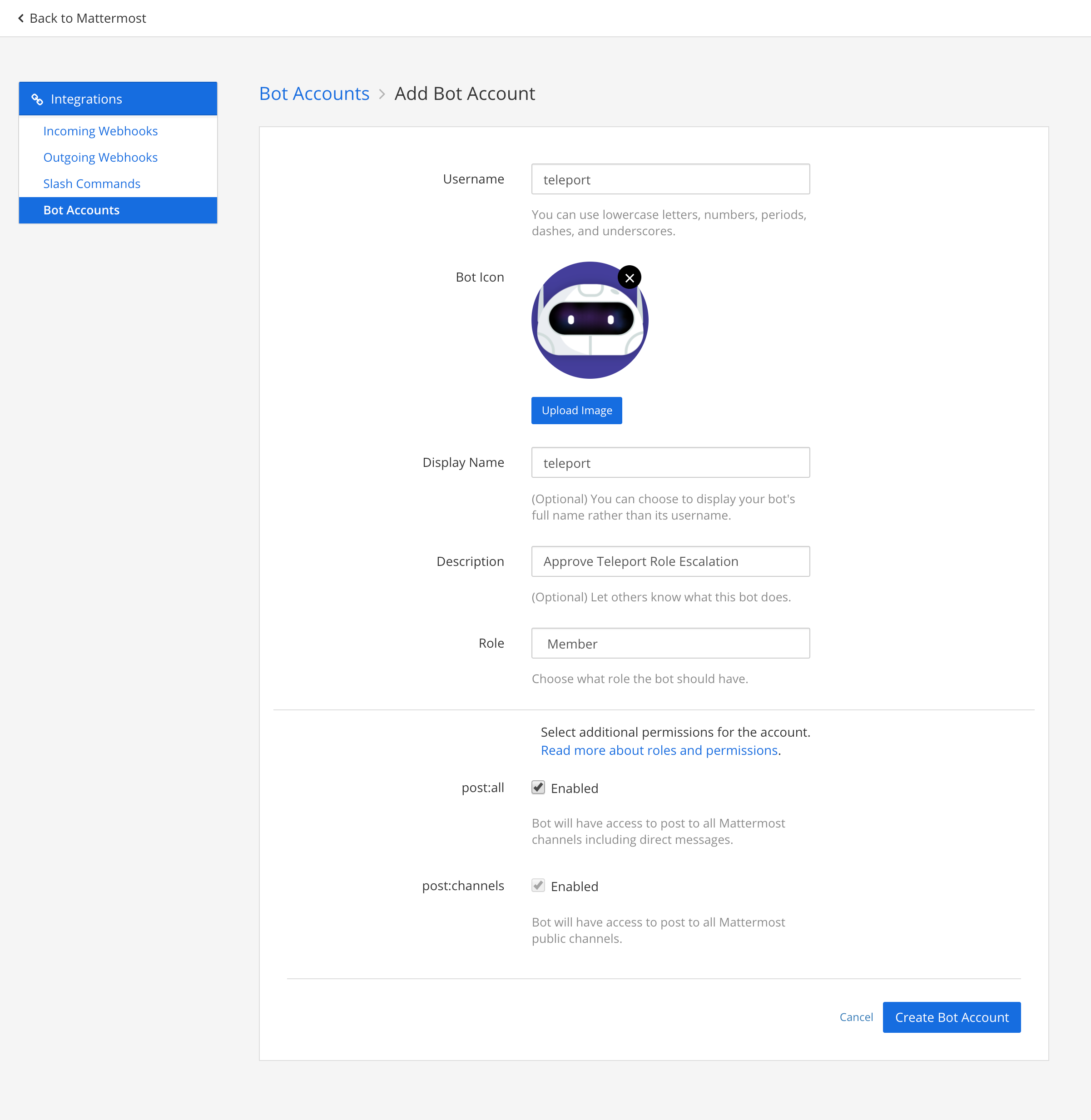
Click "Create Bot Account". We will use the resulting OAuth 2.0 token when we configure the Mattermost plugin.
Step 6/8. Configure the Mattermost plugin
At this point, you have generated credentials that the Mattermost plugin will use to connect to Teleport and Mattermost. You will now configure the Mattermost plugin to use these credentials and post messages in the right channels for your workspace.
- Executable or Docker
- Helm Chart
The Mattermost plugin uses a configuration file in TOML format. On the host where you will run the Mattermost plugin, generate a boilerplate configuration by running the following commands:
$ teleport-mattermost configure > teleport-mattermost.toml
$ sudo mv teleport-mattermost.toml /etc
The Mattermost Helm Chart uses a YAML values file to configure the plugin. On
the host where you have Helm installed, create a file called
teleport-mattermost-helm.yaml based on the following example:
(!examples/resources/plugins/teleport-mattermost-helm-cloud.yaml!)
Edit the configuration as explained below:
[teleport]
- Executable or Docker
- Helm Chart
addr: Include the hostname and HTTPS port of your Teleport Proxy Service
or Teleport Enterprise Cloud account (e.g., teleport.example.com:443 or
mytenant.teleport.sh:443).
identity: Fill this in with the path to the identity file you exported
earlier.
client_key, client_crt, root_cas: Comment these out, since we
are not using them in this configuration.
address: Include the hostname and HTTPS port of your Teleport Proxy Service
or Teleport Enterprise Cloud tenant (e.g., teleport.example.com:443 or
mytenant.teleport.sh:443).
identitySecretName: Fill in the identitySecretName field with the name
of the Kubernetes secret you created earlier.
identitySecretPath: Fill in the identitySecretPath field with the path
of the identity file within the Kubernetes secret. If you have followed the
instructions above, this will be identity.
If you are providing credentials to the plugin using a tbot binary that runs
on a Linux server, make sure the value of identity is the same as the path of
the identity file you configured tbot to generate, /opt/machine-id/identity.
Configure the plugin to periodically reload the identity file, ensuring that it does not attempt to connect to the Teleport Auth Service with expired credentials.
Add the following to the teleport section of the configuration:
refresh_identity = true
[mattermost]
url: Include the scheme (https://) and fully qualified domain name of
your Mattermost deployment.
token: Find your Mattermost bot's OAuth 2.0 token. To do so, visit
Mattermost. In the menu on the upper left of the UI, go to Integrations → Bot
Accounts. Find the listing for the Teleport plugin and click "Create New Token".
After you save the token, you will see a message with text in the format,
"Access Token: TOKEN". Copy the token and paste it here.
recipients: This field configures the channels that the Mattermost plugin
will notify when it receives an Access Request message. The value is an array of
strings, where each element is either:
- The email address of a Mattermost user to notify via a direct message when the plugin receives an Access Request event
- A channel name in the format
team/channel, where/separates the name of the team and the name of the channel
For example, this configuration will notify first.last@example.com and
the Town Square channel in the myteam team of any Access Request events:
- Executable or Docker
- Helm Chart
recipients = [
"myteam/Town Square",
"first.last@example.com"
]
recipients:
- "myteam/Town Square"
- first.last@example.com
You will need to invite your Teleport plugin to any channel you add to the
recipients list (aside from direct message channels). Visit Mattermost,
navigate to each channel you want to invite the plugin to, and enter /invite @teleport (or the name of the bot you configured) into the message box.
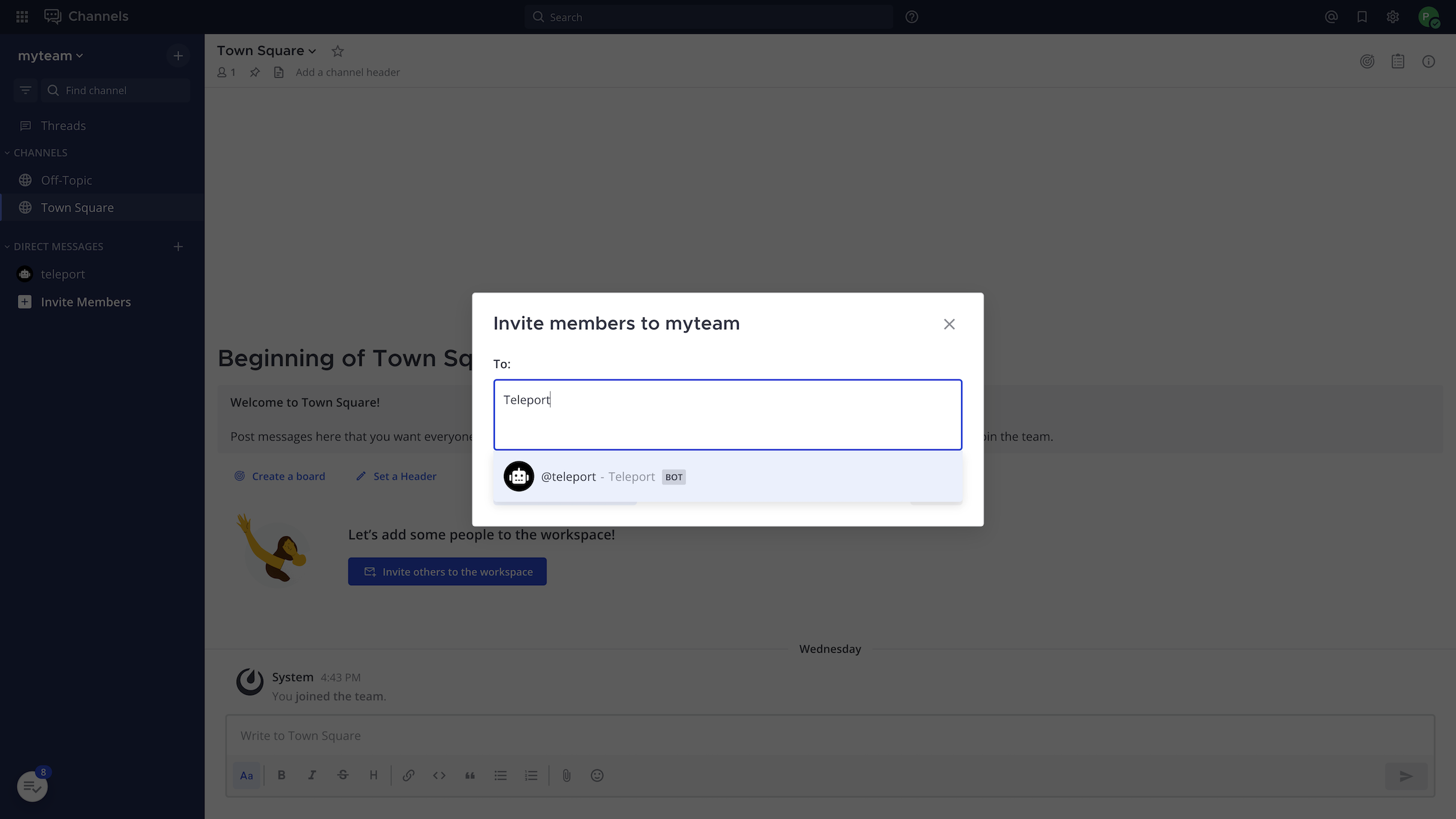
Suggested reviewers
Users can also suggest reviewers when they create an Access Request, e.g.,:
$ tsh request create --roles=dbadmin --reviewers=alice@example.com,ivan@example.com
If an Access Request includes suggested reviewers, the Mattermost plugin will add these to the list of channels to notify. If a suggested reviewer is an email address, the plugin will look up the the direct message channel for that address and post a message in that channel.
If recipients is empty, and the user requesting elevated privileges has not
suggested any reviewers, the plugin will skip forwarding the Access Request to
Mattermost.
The final configuration should look similar to this:
- Executable or Docker
- Helm Chart
# example mattermost configuration TOML file
[teleport]
auth_server = "myinstance.teleport.sh:443" # Teleport Cloud proxy HTTPS address
identity = "/var/lib/teleport/plugins/mattermost/identity" # Identity file path
refresh_identity = true # Refresh identity file on a periodic basis
[mattermost]
url = "https://mattermost.example.com" # Mattermost Server URL
token = "api-token" # Mattermost Bot OAuth token
recipients = [
"myteam/general",
"first.last@example.com"
]
[log]
output = "stderr" # Logger output. Could be "stdout", "stderr" or "/var/lib/teleport/mattermost.log"
severity = "INFO" # Logger severity. Could be "INFO", "ERROR", "DEBUG" or "WARN".
(!examples/resources/plugins/teleport-mattermost-helm-cloud.yaml!)
Step 7/8. Test your Mattermost bot
- Executable
- Docker
- Helm Chart
After modifying your configuration, run the bot with the following command:
$ teleport-mattermost start -d
The -d flag provides debug information to make sure the bot can connect to
Mattermost, e.g.:
DEBU Checking Teleport server version mattermost/main.go:234
DEBU Starting a request watcher... mattermost/main.go:296
DEBU Starting Mattermost API health check... mattermost/main.go:186
DEBU Starting secure HTTPS server on :8081 utils/http.go:146
DEBU Watcher connected mattermost/main.go:260
DEBU Mattermost API health check finished ok mattermost/main.go:19
Run the plugin:
$ docker run -v <path-to-config>:/etc/teleport-mattermost.toml public.ecr.aws/gravitational/teleport-plugin-mattermost:15.4.22 start
After modifying your configuration, run the bot with the following command:
$ helm upgrade --install teleport-plugin-mattermost teleport/teleport-plugin-mattermost --values teleport-mattermost-helm.yaml
To inspect the plugin's logs, use the following command:
$ kubectl logs deploy/teleport-plugin-mattermost
Debug logs can be enabled by setting log.severity to DEBUG in
teleport-mattermost-helm.yaml and executing the helm upgrade ... command
above again. Then you can restart the plugin with the following command:
$ kubectl rollout restart deployment teleport-plugin-mattermost
Create an Access Request
- As an Admin
- As a User
- From the Web UI
A Teleport admin can create an Access Request for another user with tctl:
$ tctl request create myuser --roles=editor
Users can use tsh to create an Access Request and log in with approved roles:
$ tsh request create --roles=editor
Seeking request approval... (id: 8f77d2d1-2bbf-4031-a300-58926237a807)
Users can request access using the Web UI by visiting the "Access Requests" tab and clicking "New Request":
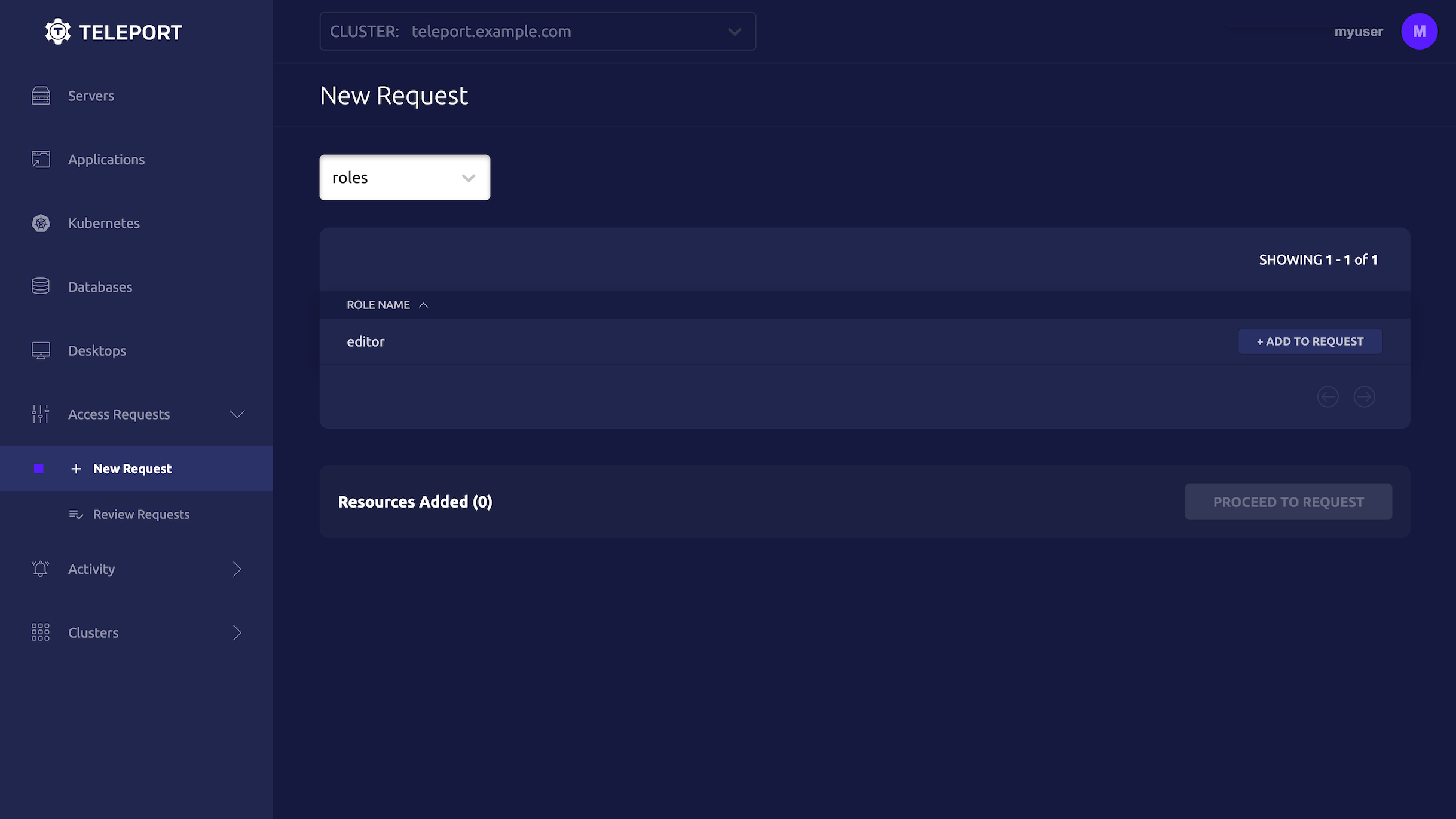
The users and channels you configured earlier to review the request should receive a message from "Teleport" in Mattermost allowing them to visit a link in the Teleport Web UI and either approve or deny the request.
Resolve the request
Once you receive an Access Request message, click the link to visit Teleport and approve or deny the request:
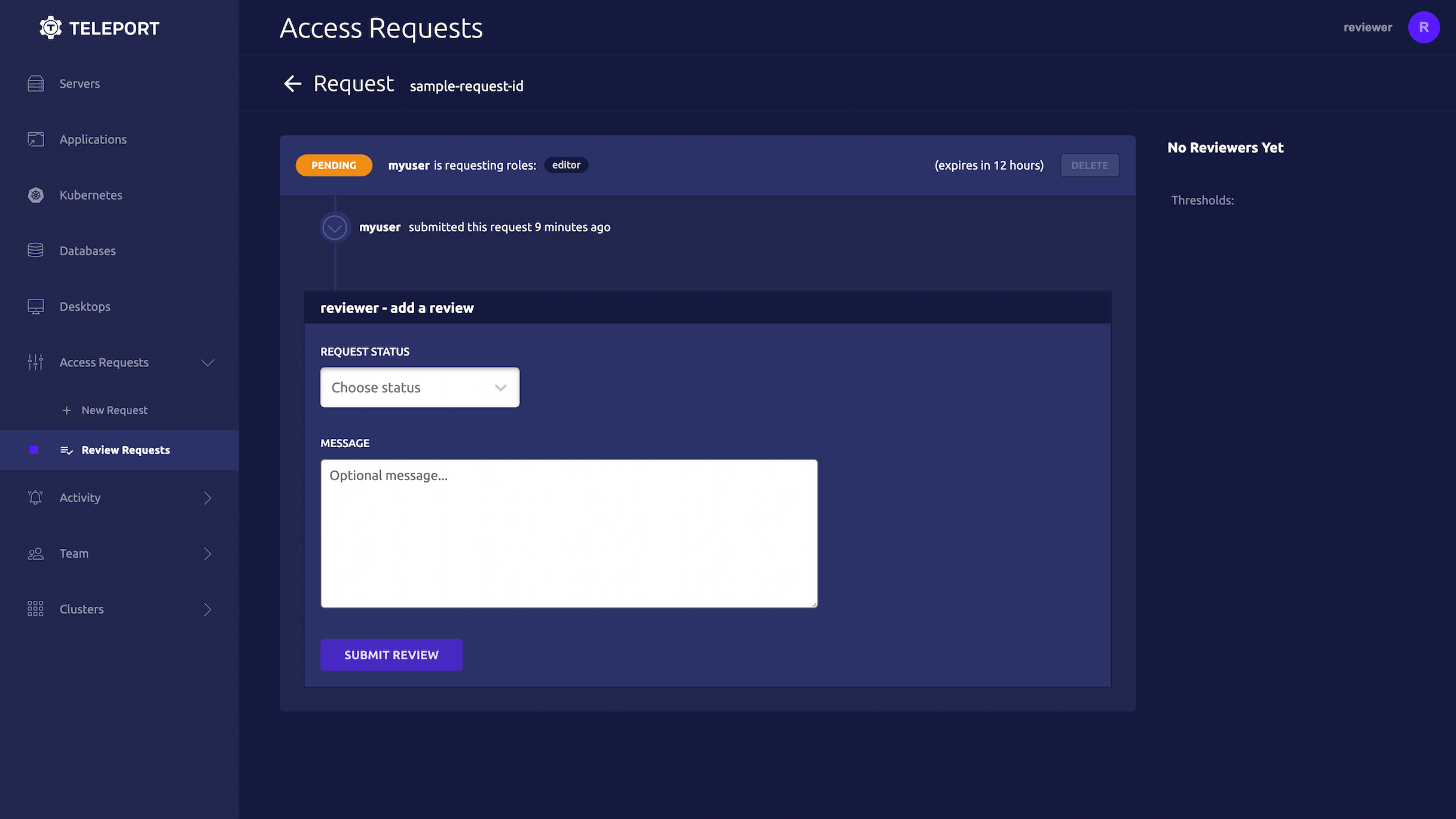
Reviewing from the command line
You can also review an Access Request from the command line:
- As an Admin
- As a User
# Replace REQUEST_ID with the id of the request
$ tctl request approve REQUEST_ID
$ tctl request deny REQUEST_ID
# Replace REQUEST_ID with the id of the request
$ tsh request review --approve REQUEST_ID
$ tsh request review --deny REQUEST_ID
When the Mattermost plugin posts an Access Request notification to a channel, anyone with access to the channel can view the notification and follow the link. While users must be authorized via their Teleport roles to review Access Requests, you should still check the Teleport audit log to ensure that the right users are reviewing the right requests.
When auditing Access Request reviews, check for events with the type Access Request Reviewed in the Teleport Web UI.
Step 8/8. Set up systemd
This section is only relevant if you are running the Teleport Mattermost plugin on a Linux host.
In production, we recommend starting the Teleport plugin daemon via an init system like systemd. Here's the recommended Teleport plugin service unit file for systemd:
(!examples/systemd/plugins/teleport-mattermost.service!)
Save this as teleport-mattermost.service in either /usr/lib/systemd/system/ or
another unit file load
path
supported by systemd.
Enable and start the plugin:
$ sudo systemctl enable teleport-mattermost
$ sudo systemctl start teleport-mattermost